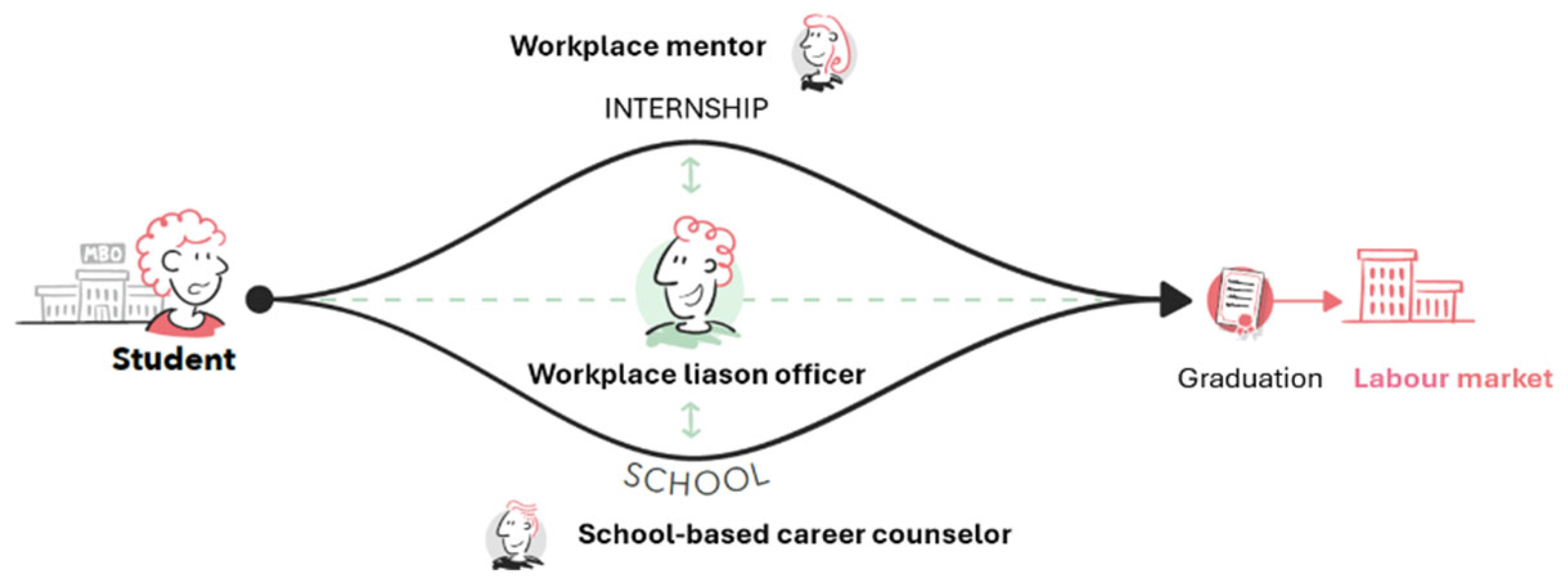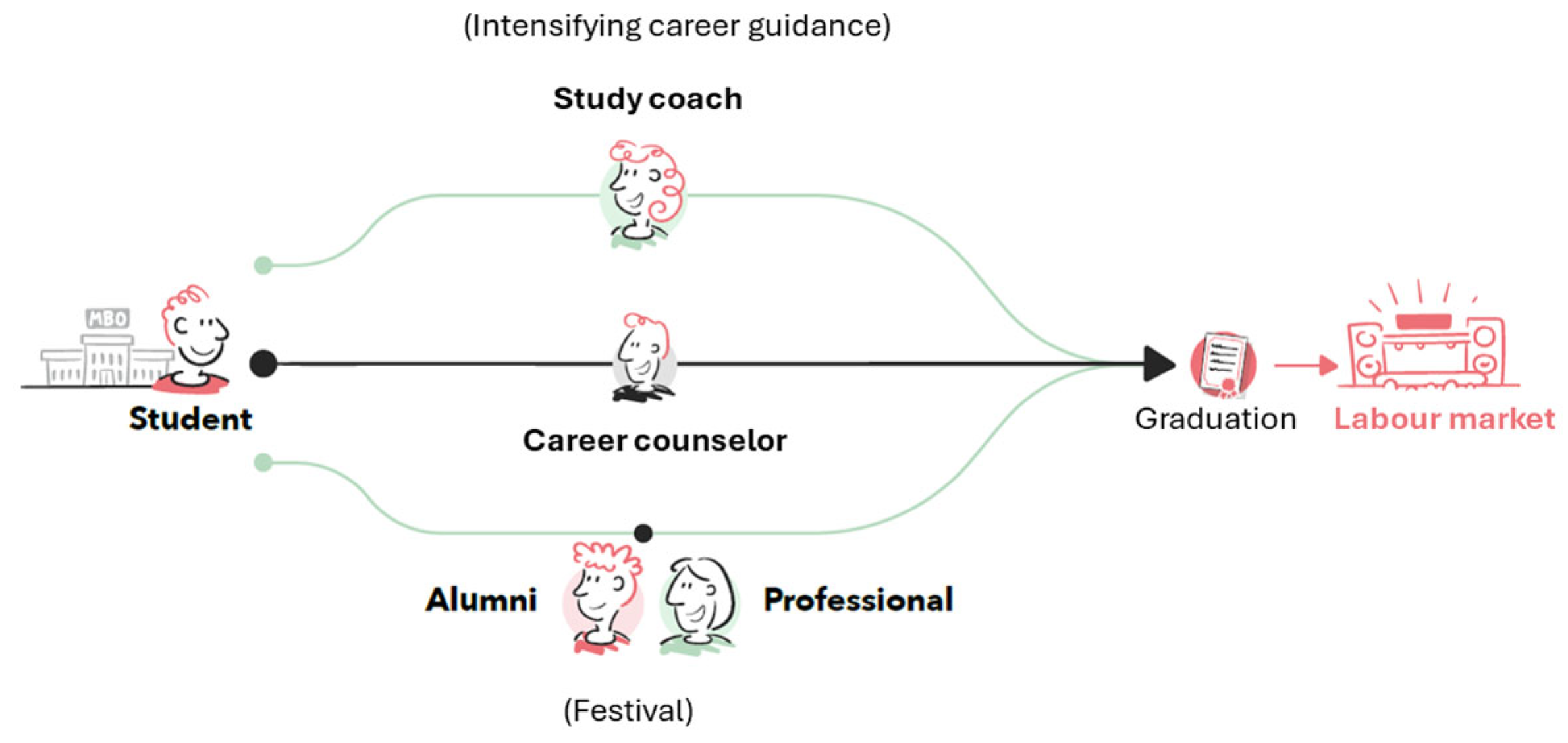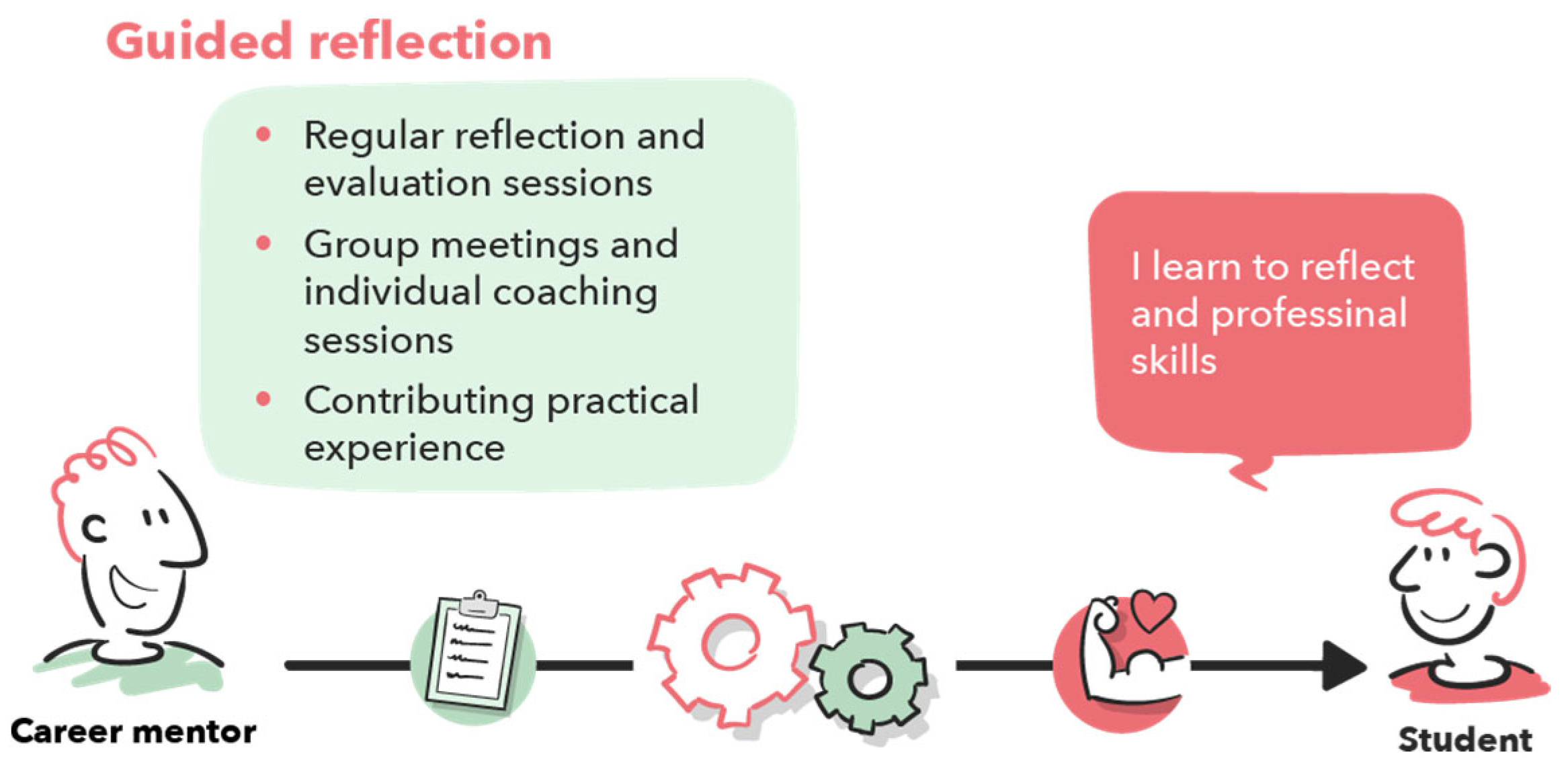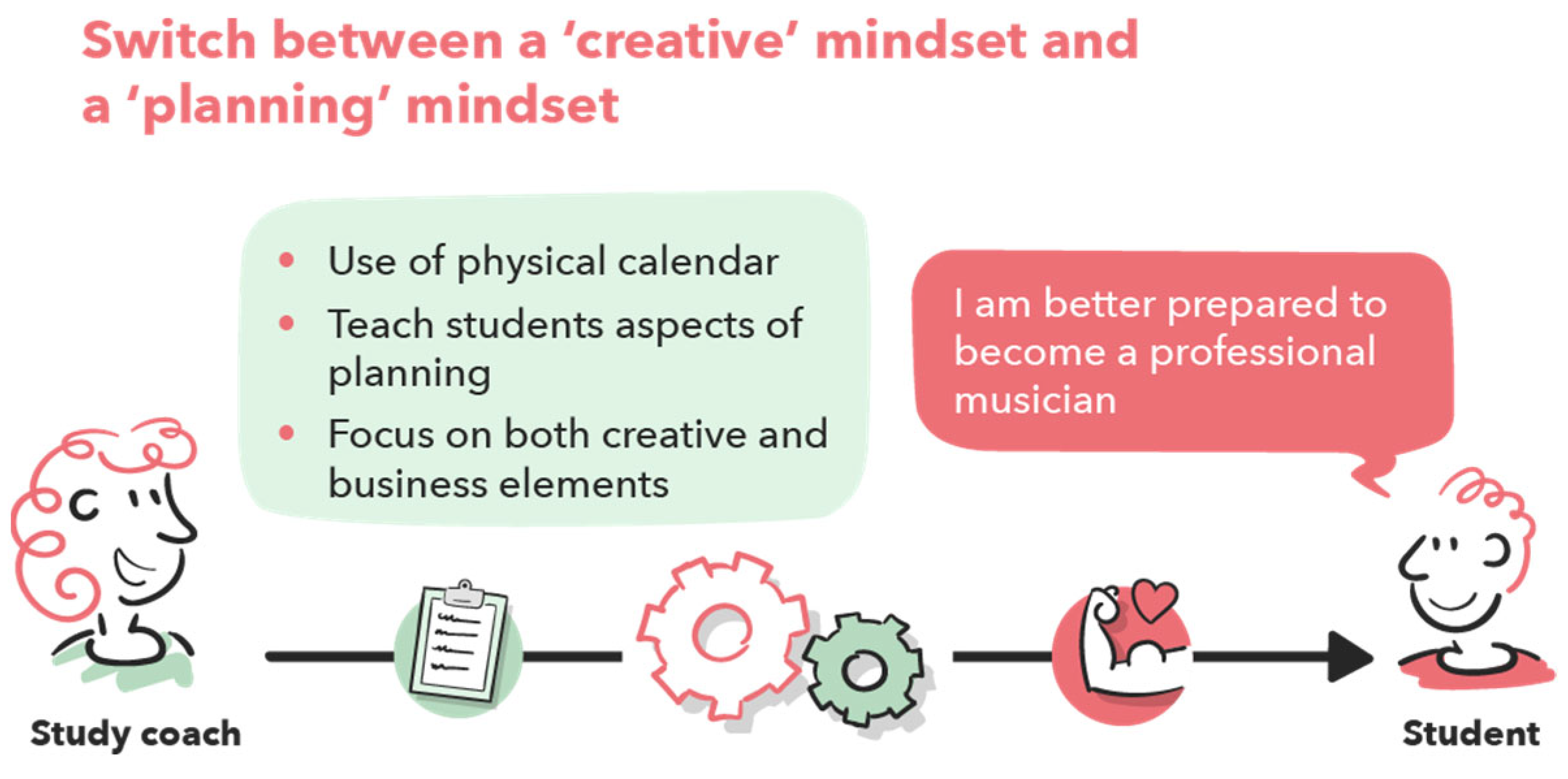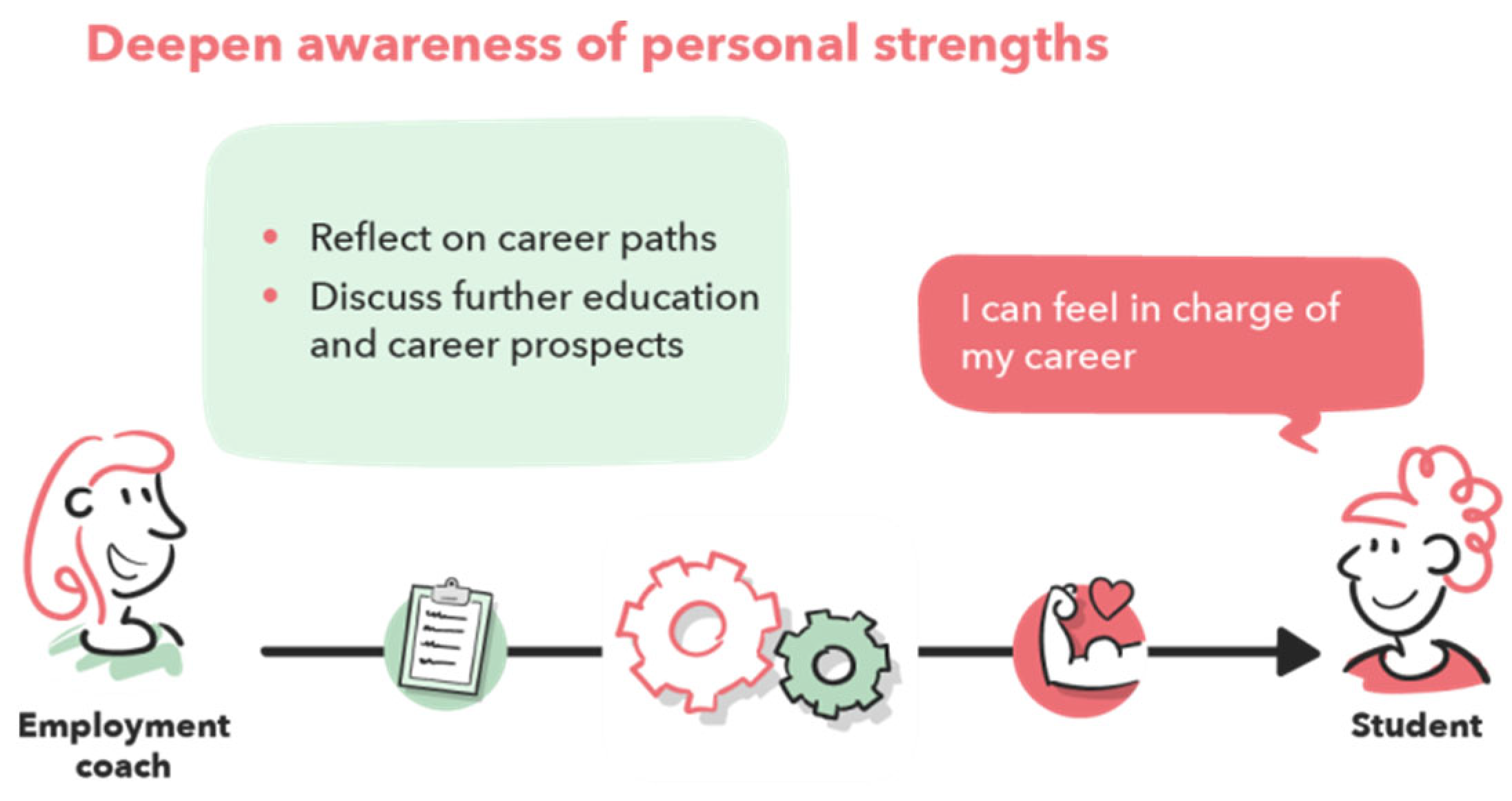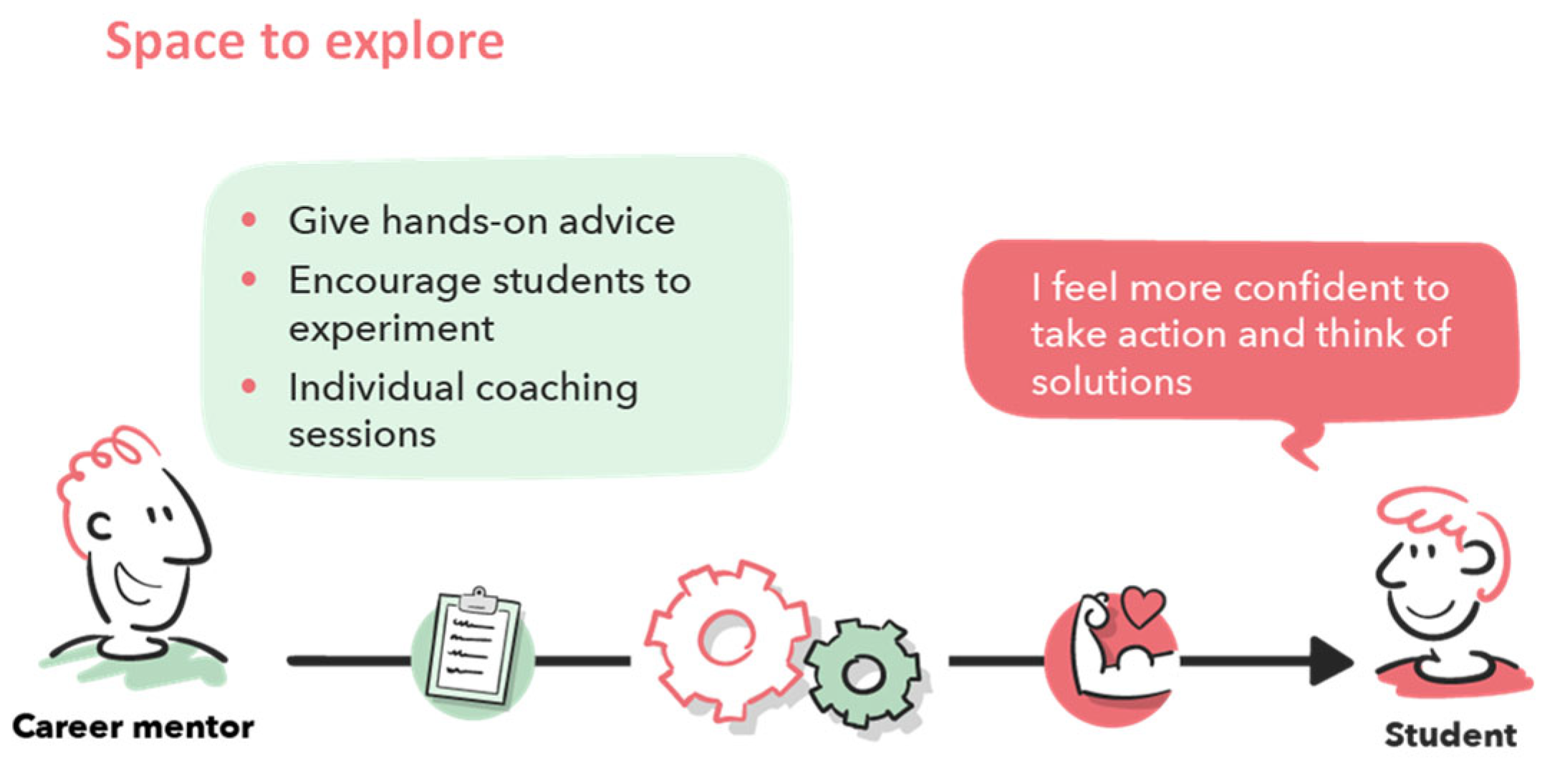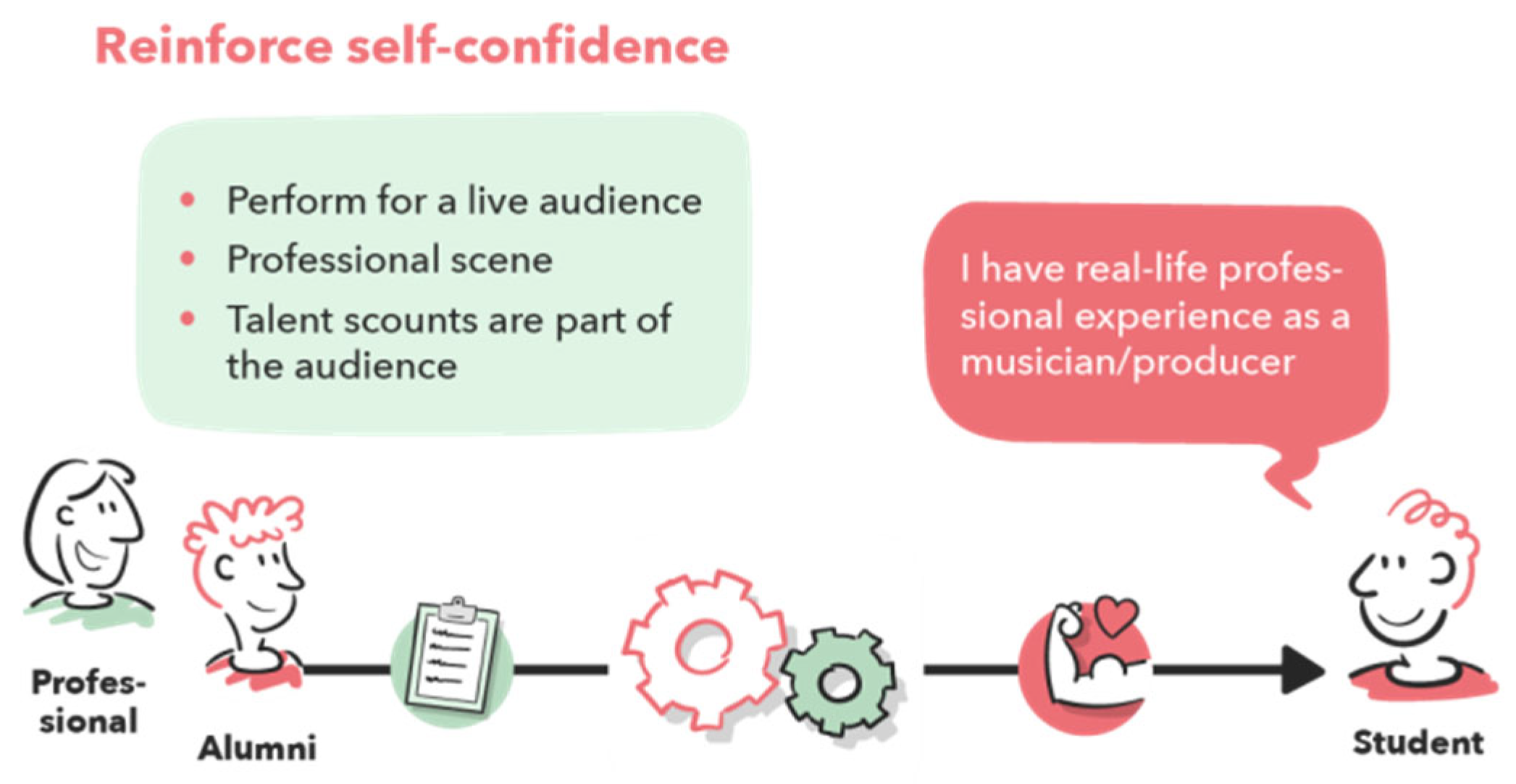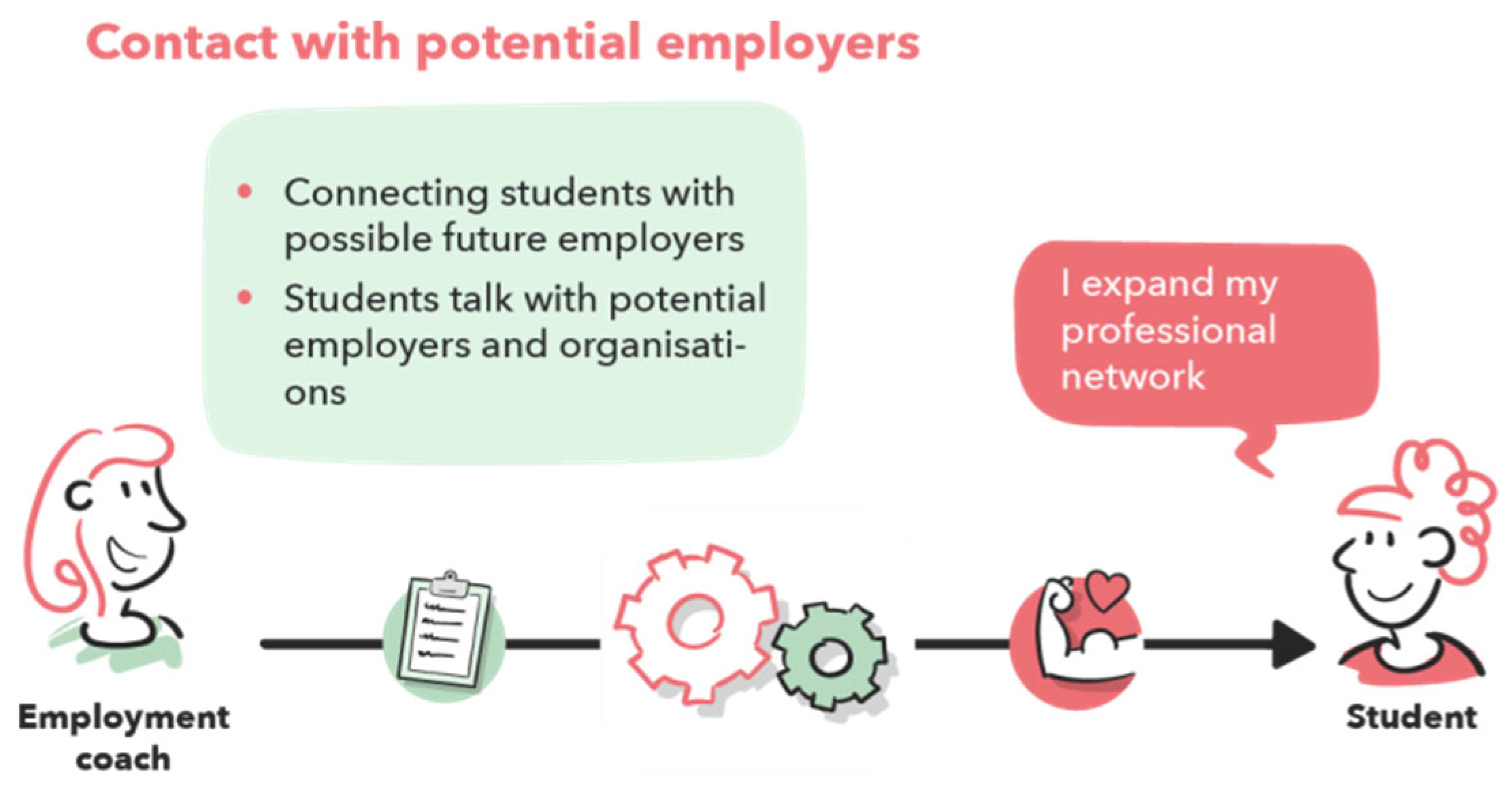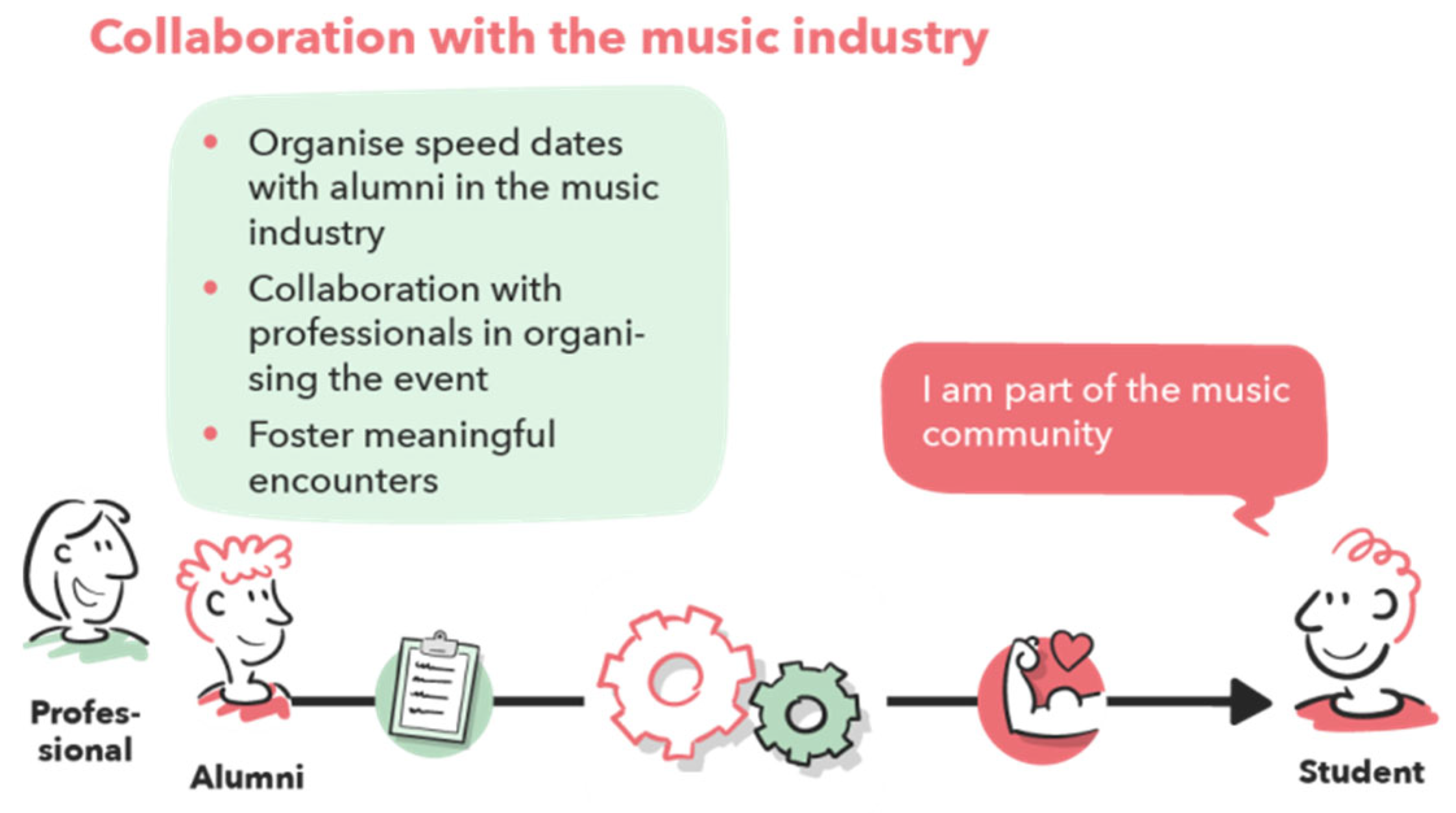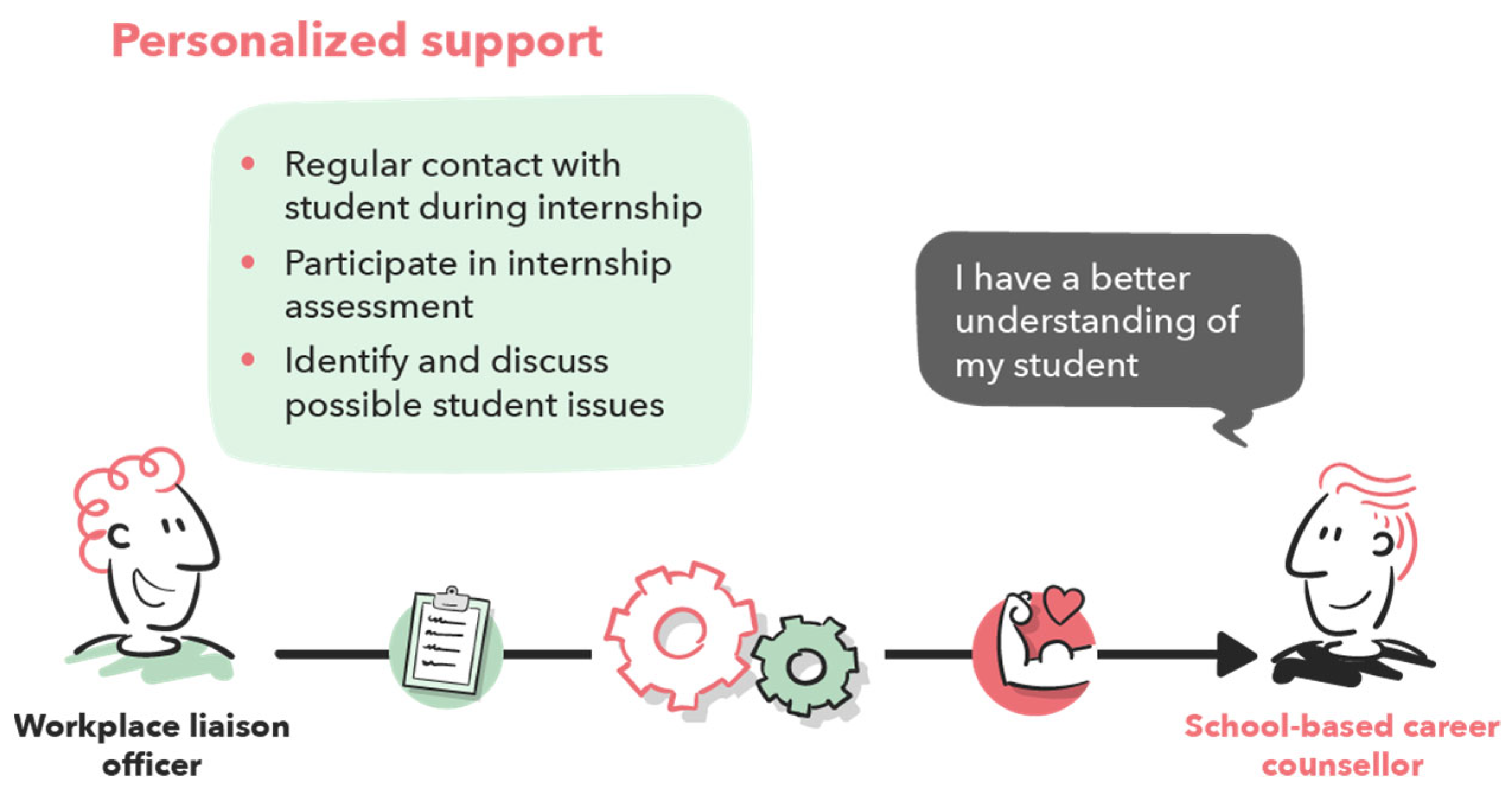1. Introduction
Many students struggle to transition from education to work. In today’s society, securing sustainable career opportunities can be difficult for young people (
Psifidou et al. 2022), which is reflected in the high rates of educational dropout. Across Europe, an average of 9.5% of individuals aged 18–24 have completed at most lower secondary education and are not engaged in further education or training, such as vocational education and training (VET) (
Eurostat 2024). Although the dropout rate in the Netherlands is lower (6.5%), it still represents a substantial group of young people at risk (
NJi 2024).
A clear conceptual distinction between dropout and transition is essential for understanding the challenges young people face during the school-to-work trajectory. In this article, we define dropout as the premature termination of education before attaining a formal qualification, whereas transition refers to the broader process that begins in the final phase of education and continues into initial labour market participation or further studies. Therefore, dropout can be conceptualised as a disruption within the transition process. Consistent with this view,
Masdonati et al. (
2010) define a successful transition as one that culminates in a relatively stable position in the labour market, noting that attrition from vocational education and training (VET) may signal a failure in this trajectory.
Even the completion of a VET programme does not necessarily imply a smooth transition. For instance, in the Netherlands, approximately 10% of VET graduates are neither employed, nor engaged in further education, nor receiving social benefits one year after graduation (
Ministry of Education, Culture and Science 2024). This concern has also been acknowledged at the policy level: the Dutch Minister of Education recently observed that “A disproportionately large group of young people falls through the cracks during the crucial transition from school to work. (…) We see that these young people often struggle to take the step to the labour market on their own.” (
Rijksoverheid 2024).
The COVID-19 pandemic further amplified the barriers to school-to-work transitions. In the Netherlands, the closure of sectors such as hospitality, healthcare, and services, combined with the reduced availability of internships and practical placements, hindered students’ opportunities to build professional experience and networks (
SBB 2022). These developments contributed both to rising dropout rates and more difficult transitions. In addition, recent research highlights that many young people, particularly disadvantaged youth and early school leavers, often lack the knowledge, skills, and/or motivation required to meet labour market demands (
Cedefop and Refernet 2023).
In response, Dutch VET institutions implemented a range of government-funded interventions during and shortly after the pandemic. These initiatives aimed to support students in completing their education and transitioning to employment or further study (
Ministry of Education, Culture and Science 2022). However, despite these efforts, knowledge remains limited regarding how such interventions are structured and why they may be effective.
Research suggests that effective career guidance and support during education can improve students’ motivation, help them make informed career choices, and build trust in their own capacities, especially for those at risk of disengagement (
Psifidou et al. 2022). In addition, skill development is essential for sustainable labour market transitions (
Saks 2014). VET programmes that embed employability and entrepreneurial skills—such as initiative-taking and resourcefulness—are positively associated with long-term career outcomes (
Blokker et al. 2023;
Kolho et al. 2022). However, during the COVID-19 period, students had fewer opportunities to develop these skills.
Providing students with early exposure to real-world work environments, such as through internships or cooperative education, can enhance employability by linking education to labour market needs (
Silva et al. 2016;
Psifidou et al. 2022). This insight has gained renewed attention in the Netherlands, including through recent legislative proposals such as “From School to Sustainable Employment”. This initiative aims to strengthen support for young people under 27 years of age in their transition from education to the labour market, including the option of extended career guidance after graduation or early school leaving (
Eerste Kamer der Staten-Generaal 2025).
Despite the increased focus, the mechanisms through which interventions succeed in reducing dropouts and facilitating transitions remain underexplored. This study aims to fill this gap by identifying and describing the key elements of selected interventions designed to support students in their school-to-work transitions. Drawing on a qualitative study of four interventions implemented at two Dutch VET institutions, Albeda (Rijnmond region) and Firda (Friesland and Flevoland), we examine ‘Co-creating Guidance’, ‘Post-graduation Support’, ‘Career Mentor’, and ‘Talent Development’. Eleven key elements were identified that contributed to reducing dropouts and supporting transitions. This article specifically focuses on student-level elements.
The article is structured as follows: we begin with the methodology, followed by the
Section 4, in which we present the identified key elements. We conclude with a discussion of our findings in light of the existing literature and outline the implications, limitations, and directions for future research and practice.
3. Participants & Procedures
3.1. Process
This study employed multiple data collection methods to capture a comprehensive understanding of the interventions. We adopted an iterative research approach, meaning that after each round of data collection, we critically reflected on the gaps in the gathered information and refined subsequent data collection accordingly. Data were collected from two key groups: professionals involved in the design or implementation of the interventions, and students who participated in them. To ensure a nuanced perspective, different data collection methods were applied to each group, as described below.
To structure our analysis and interpretation of the data, we used the CIMO-logic (Context, Intervention, Mechanism, Outcome) as an analytical framework. This allowed us to systematically examine how each intervention operated within its specific context, the mechanisms that were activated, and the outcomes that were achieved.
3.2. Professionals
After selecting the different case studies, we conducted a series of individual and group interviews with three to four relevant stakeholders per case. These stakeholders held various roles, including directors, project leaders, educational leaders, teachers, and career counsellors. In these conversations, we mapped out the rationale behind each intervention and explored its design and intended effects.
As part of our CIMO-based analytical approach (
Denyer et al. 2008), we worked with the professionals to co-construct both a problem chain and an intervention chain for each case. These chains were used to clarify the underlying logic of the intervention: what context-specific problems it sought to address (C), what intervention was developed in response (I), and what outcomes were intended (O). This process also served to identify professionals’ own assumptions about how change would occur through the intervention.
The development of these chains was conducted iteratively. Initial versions were drafted based on interviews and subsequently refined during follow-up sessions, allowing for validation and adjustment in collaboration with the participants. Once the desired outcomes were clearly articulated, we focused on identifying the mechanisms (M)—that is, the underlying processes through which the interventions were expected to lead to the intended results.
Following these steps, we organised one to two focus group sessions per case. These sessions aimed to deepen understanding of the interventions by discussing whether, and how, they could contribute to reducing school dropout and youth unemployment. The intervention descriptions were subsequently revised based on insights gained during these discussions.
Toward the end of the project, we held six reflection sessions to explore the transferability of the interventions to other educational contexts. These sessions focused on the two approaches considered most widely applicable—Career Mentor and Post-graduation Support—and included professionals from other programs and institutions. Each session lasted between one and two hours and involved four to fifteen participants. See
Table 1 and
Table 2 for an overview of the participants.
3.3. Students
To gain insight into how participants experienced the interventions, data were collected from students as well. The data collection began with a questionnaire designed to provide an initial overview of students’ reflections on the interventions. In developing the questionnaire, careful consideration was given to the target group, and efforts were made to keep it concise (approximately ten questions). An additional purpose of the questionnaire was to obtain consent to contact students at a later stage for a follow-up questionnaire or interview. The questionnaires were administered in the classroom, with at least one class approached for each case. Following the questionnaires, in-depth interviews were conducted with twelve students across the four cases, focusing on their experiences with the interventions and how these contributed to their transition to the labour market. At a later stage, after distributing a second questionnaire, three students participated in a second interview to further interpret the analysed findings.
3.4. Data Analysis
For the data analysis, we applied the CIMO (Context, Intervention, Mechanism, Outcome) logic to systematically structure and interpret the qualitative data. CIMO depicts the central form of causal reasoning within a realist evaluation. This approach seeks to explain why, for whom and in what circumstances a desired change of outcome works (
Pawson and Tilley 1997).
We developed a framework in which all qualitative data were categorised according to the four CIMO components, enabling a layered understanding of how each intervention contributed to the intended outcomes. In order to do so, within-case analysis as well as across-case analysis took place (
Ayres et al. 2003). By applying this approach, we were able to trace the underlying mechanisms linking specific interventions to their intended outcomes within particular contexts. To ensure analytical rigour and maintain a close connection to both the data and the actual context of the interventions, the analyses for all four approaches were conducted collaboratively by multiple members of the project team (
Green and Thorogood 2018).
The process of data collection and analysis was iterative (
Green and Thorogood 2018), with ongoing refinement of the emerging CIMO configurations. As new data were gathered, preliminary interpretations were revisited to ensure a deeper understanding of the relationships between context, intervention, mechanisms, and outcomes. Memos were written throughout the coding process to capture conceptual linkages and evolving insights.
In addition to identifying the relationships between context, intervention, mechanisms, and outcomes, the CIMO configurations were further analysed based on the types of mechanisms involved and how these mechanisms contribute to preventing student dropout. A literature review was conducted to establish a theoretical foundation for classifying these mechanisms. Through this substantive analysis, it became evident that certain mechanisms within the interventions were aimed at enhancing students’ abilities, such as skill development or knowledge acquisition. Other mechanisms focused on increasing motivation, for instance, by fostering engagement, self-efficacy, or a sense of belonging. Finally, some mechanisms worked by creating opportunities, such as improving access to resources, networks, or practical learning experiences.
4. Results
The aim of this study was to identify key elements that contribute to a smoother transition into the labour market of VET students. Based on interviews and sessions with educational staff, a range of CIMO configurations (Context–Intervention–Mechanism–Outcome) emerged. In this section, we present these CIMO configurations. The different configurations (fourteen in total) can be grouped into five overarching themes: skills and competencies, self-insight, self-efficacy, building a professional network, and bridging education and practice. Below, we describe the various CIMO configurations within each of these categories. This description is supported by visual representations (
Figure 5,
Figure 6,
Figure 7,
Figure 8,
Figure 9,
Figure 10,
Figure 11,
Figure 12,
Figure 13,
Figure 14 and
Figure 15) of the configurations, developed in collaboration with Buro Brand. Using visual facilitation techniques, Buro Brand assisted us in making the CIMO configurations visually and thus more accessible and comprehensible. The figures can be interpreted as follows: the intervention is shown in the green box, the mechanism is indicated by the title of the figure, and the outcome appears in the pink box on the right. The Context of each intervention is detailed in the case study boxes above.
4.1. Skills and Competencies
Across the CIMO configurations, a shared emphasis emerged on expanding students’ repertoire for action. This involves the development of communication skills, job application competencies, workplace and professional behaviours (such as punctuality and planning), and reflective abilities. These competencies were addressed in three of the four cases.
In the Post-Graduation Support case, teachers described interventions aimed at strengthening students’ practical competencies for entering the labour market. One such intervention involved training students in job-application techniques. By providing concrete instructions in this area, students’ self-confidence was expected to increase, thereby enhancing their performance in job interviews as an intended outcome.
Figure 5.
CIMO skills and competencies—Post-graduation support.
Figure 5.
CIMO skills and competencies—Post-graduation support.
In the Career mentor case, teachers also formulated a CIMO configuration focused on strengthening students’ professional competencies. The intervention consisted of regular reflection and evaluation sessions conducted both in groups and individually. The career mentor, who was always a professional with experience in the care sector, contributed practical, context-specific knowledge. Through guided reflections on challenges and successes, students gained insights into effective and ineffective practices. These reflective processes enabled students to clarify dilemmas, confront uncertainties, and develop a more grounded understanding of their professional roles. Targeted questioning by the coach stimulated critical thinking and encouraged students to independently assess advice and solutions, thereby enhancing their problem-solving capacities and reducing insecurity. The intended outcome was the development of core professional competencies, including reflective capacity, communication skills, and professional workplace behaviour. Additionally, working through scenarios with a (former) professional enabled students to practice and internalise the communicative strategies for resolving workplace issues.
Figure 6.
CIMO skills and competencies—Career mentor.
Figure 6.
CIMO skills and competencies—Career mentor.
In the Talent Development case, teaching staff identified interventions that supported students in acquiring the skills and competencies necessary for a successful transition to the labour market. A key challenge in this context was helping students navigate the creative aspects of their education (e.g., music production) and the more business-oriented side of the profession. One intervention involved guiding students to use physical planners or calendars to organise their activities. By learning to switch between a “creative” mindset and a “planning” mindset, students were able to develop the business skills required in the music industry. The intended outcome was to better equip students for the entrepreneurial and organisational aspects of a career in music. The development of these planning and organisational skills was seen as crucial for sustaining a successful professional trajectory in this field.
Figure 7.
CIMO skills and competencies—Talent development.
Figure 7.
CIMO skills and competencies—Talent development.
4.2. Self-Insight
One identified CIMO configuration involves a process aimed at fostering students’ self-insight, including a clearer understanding of their personal needs, values, and aspirations, and how these relate to their educational pathways or future careers. This increased self-insight can foster a stronger sense of ownership over students’ learning trajectories and help them recognise the value of their educational experiences. Interventions aimed at enhancing students’ self-insight were identified in one of the four cases: Post-Graduation Support.
In the Post-Graduation Support case, teachers described interventions that encouraged students to reflect on their career goals and opportunities. For example, students participated in regular reflective sessions that focused on career prospects in the healthcare sector. Through the use of reflective dialogue techniques and a supportive, open-ended approach, students were encouraged to actively consider their challenges and potential solutions. This process could help students deepen their awareness of personal strengths and areas for growth and support the development of autonomous decision-making. By fostering initiative and providing accessible guidance, students gained practical experience in implementing their own solutions. As such, students gained insight into the relevance of particular skills and knowledge for building sustainable careers. The intended outcome of these interventions was to strengthen students’ sense of agency and independence, enabling them to make informed and meaningful decisions regarding their future educational and professional trajectories.
Figure 8.
CIMO Self-insight—Post-graduation support.
Figure 8.
CIMO Self-insight—Post-graduation support.
4.3. Self-Efficacy
Some CIMO configurations focus on enhancing students’ self-confidence. Through receiving targeted advice, engaging in guided reflection, and having opportunities to practice and experiment, students experience increased confidence. This, in turn, enables them to take greater ownership of their learning processes and develop their own strategies for addressing challenges. These competencies were addressed in three of the four cases. Co-creating guidance, Career mentoring, and Talent Development.
In the Co-creating Guidance case, the respondents indicated that many students lacked a clear view of their future and struggled with low confidence and motivation. To address this, the intervention involved continuous support from a workplace liaison officer who engaged students in motivational conversations and focused on their strengths and interests. This strengths-based approach created a supportive environment in which students felt valued, even when they made mistakes. By expressing trust and encouraging self-reflection, students gained insights into their own capacities and goals. This is intended to enhance their sense of control and motivation, making them more likely to actively engage in their internships and complete them successfully.
Figure 9.
CIMO self-efficacy—Co-creating guidance.
Figure 9.
CIMO self-efficacy—Co-creating guidance.
In the case of the Career mentor in both group and individual sessions, the career mentor encouraged students to initiate concrete actions and conversations within their internship settings. As these forms of professional engagement were often not directly supported in the workplace, students were asked to take ownership of their learning process. During follow-up coaching meetings, the students reflected on what they had attempted and how it went, allowing the identification of possible next steps. This iterative process with space for exploration enabled students to test new approaches and critically assess their learning experiences. By making independent decisions and evaluating their effectiveness, students developed a sense of responsibility and self-regulation. By experiencing small successes and receiving constructive feedback, the intended outcome was that students would gradually build confidence in their ability to manage their educational and professional development.
Figure 10.
CIMO self-efficacy—career mentor.
Figure 10.
CIMO self-efficacy—career mentor.
Within the Talent Development case, the Albeda Musician/Producer programme organised performance-based festivals as part of vocational training and assessment. A two-day network festival was organised, involving students, faculty, and alumni in co-creating the event. The festival took place at various music venues in Rotterdam, featuring performances, film screenings with live music, panel discussions, and speed dates. Performing on a professional stage offers students authentic experiences and success in a real-world context. Positive audience feedback could further reinforce their self-confidence and sense of connection to the music industry. The primary intended outcome was that students would gain valuable real-life experience, which could enhance their readiness to transition into the professional music sector.
Figure 11.
CIMO self-efficacy—Talent development.
Figure 11.
CIMO self-efficacy—Talent development.
4.4. Building a Professional Network
Several CIMO configurations show that students actively work to expand their networks of potential employers, clients, and colleagues. This early development of professional connections allows them to enter the labour market with an established network they can draw on after graduation. These competencies were addressed in two cases: post-graduation support and Talent Development.
A CIMO configuration identified in the Post-Graduation Support case highlights the importance of helping students build a professional network. These interventions focused on expanding students’ access to social capital by connecting them to employers, professionals, and organisations that could support their transition into the labour market. Through guided introductions and targeted referrals, students were enabled to establish contact with potential employers, mentors, or peers within relevant sectors. Access to professional networks serves multiple functions. First, it increases students’ exposure to job opportunities and labour market trends, making them more informed and better positioned to make career-related decisions. Second, the opportunity to interact with experienced professionals offered valuable insights, mentorship, and feedback, fostering both confidence and career readiness. Third, the network itself could become a source of motivation and inspiration, allowing students to connect with others who share similar professional aspirations. The intended outcome of these interventions was to enhance students’ social embeddedness within the labour market, thereby improving their employability and long-term career prospects.
For the Talent Development case, the organised festival was a moment for students to work on their professional networks. The festival setting was designed to foster encounters, experience sharing, networking, and offering authentic performance experiences. Talent scouts and industry representatives are present, offering students opportunities to engage directly with the professional field. Through close collaborations with industry professionals, students begin to integrate into the music community while still in training. The informal and accessible nature of the festival facilitates the establishment of meaningful connections. Students and alumni can use the platform to present themselves as emerging professionals and establish their presence in the professional music community. These informal networks often provide opportunities for collaboration and access to paid employment. The intended outcome is for students to become part of the existing music community. Through networking and professional exposure, they develop business skills and expand their contacts, thereby increasing their chances of building a sustainable career in the industry.
Figure 12.
CIMO Building a professional network—Post-graduation support.
Figure 12.
CIMO Building a professional network—Post-graduation support.
Figure 13.
CIMO: Building a professional network—Talent development.
Figure 13.
CIMO: Building a professional network—Talent development.
4.5. Bridging Education and Practice
In multiple CIMO configurations, a strong connection was established between education and professional practice, either by integrating the experiences of practitioners or by placing students in supervised professional settings. These forms of exposure can enhance student motivation and contribute to a better transition from education to the workplace. These competencies were addressed in co-creating guidance and career mentoring.
In the Co-creating guidance case, a CIMO configuration demonstrated how structured guidance helped bridge the gap between school and the workplace. A key intervention involved the introduction of a workplace liaison officer who acted as a consistent point of contact throughout the internship period before, during, and after placement. By maintaining regular contact with both students and workplaces, the liaison officer facilitated the alignment of the school’s expectations with the realities of professional practice. This helped translate learning goals into concrete workplace experiences and ensured the early identification and resolution of potential challenges. The intended outcome was twofold: students experienced a smoother transition into the work environment and developed a better understanding of how their education connected to their future professional role. This alignment is intended to support more meaningful learning and reduce the risk of dropout.
Figure 14.
Bridging education and practice—Co-creating guidance.
Figure 14.
Bridging education and practice—Co-creating guidance.
In the Career mentor case, students engaged with (former) healthcare professionals at several points. Career mentors are experienced practitioners, such as nurses, managers, and psychologists, who integrate their real-world insights into one-on-one coaching sessions. These coaches share personal insights, motivations, and practical advice to help students explore the healthcare field beyond the classroom. By drawing on their own practical experience, career mentors help to bridge the gap between education and professional practice. This approach aims to narrow the education-practice divide. Practical insights may help students form a clearer, more realistic view of the field, which can increase the likelihood of informed career choices and successful transitions into the workforce.
Figure 15.
Bridging education and practice—Career mentor.
Figure 15.
Bridging education and practice—Career mentor.
5. Discussion and Conclusions
5.1. Interpretation of Findings
This paper aimed to identify the key elements of interventions that support the transition of VET students to the labour market. Five key elements emerged at the student level: Skills and competencies, Self-insight, Self-efficacy, Building a professional network, and Bridging education and practice. Each of these key elements was based on CIMO configurations.
Previous literature has also shown the importance of the five key elements identified in this study to work on the prevention of youth unemployment and ease the transition from school to the labour market. For example, focusing on gaining relevant abilities, such as employee, relational, or communication skills, is important to stimulate youth employment (
Franken and Mateman 2019;
Minnaert et al. 2021;
Soeterik et al. 2024). Networking has also proven to be a valuable activity for promoting youth employment, particularly for individuals who may not yet possess a professional network (
Korpershoek et al. 2022). Additionally, self-insight has been identified as an important factor in interventions that promote the transition from school to work (
Korpershoek et al. 2022;
Kuijpers and Meijers 2009;
Masdonati et al. 2022;
Mittendorff et al. 2017;
van der Baan et al. 2022). The literature also shows the importance of gaining self-efficacy or the belief in one’s skills and experience, particularly for the transition from school to work (
Kuijpers and Meijers 2009;
Minnaert et al. 2021;
Masdonati et al. 2022). A confident student can reflect on how their skills relate to the required skills for a new job. Similarly, bridging education and practice is reported to be an important factor in easing the transition between school and work (
Franken and Mateman 2019;
Korpershoek et al. 2022;
Minnaert et al. 2021), as it realistically prepares students for the expectations set at their new job as professionals.
Supervisors also play a role in bridging the gap between education and practice by helping students apply theoretical knowledge in real-world contexts (e.g.,
van der Baan et al. 2025). This can be achieved by expanding students’ professional networks and introducing them to potential employers and industry contacts, thereby increasing their opportunities in the labour market.
Bourdieu’s (
1986) theory of Social Capital supports the importance of networking, as it provides valuable sources which are essential for labour market success. Continuous monitoring and timely feedback support students in identifying areas for improvement and building resilience, while encouraging self-reflection enhances their self-awareness and career decision-making (
Ceelen et al. 2018,
2023). By integrating these elements into guidance practices, supervisors contribute to students’ motivation, skills, and confidence, ultimately strengthening their positions in the labour market.
The various CIMO configurations presented in this study, grouped under the five key elements, are all designed to support the prevention of student dropout in vocational education. When analysing these five elements, it becomes apparent that they each contribute to different dimensions of student retention and a successful transition to the labour market. Some primarily address student motivation, while others target ability development or the creation of opportunities for students. This tripartite distinction aligns with the well-known AMO model developed by
Appelbaum et al. (
2000), which conceptualises performance as a function of Ability, Motivation, and Opportunity. Indeed, previous literature has also shown the importance of ability development (
Saks 2014;
Blokker et al. 2023) and motivation (
Behr et al. 2021;
Jorgensen et al. 2009) and creating opportunities to build professional networks and gain early exposure to the labour market (
Silva et al. 2016) are helpful for a successful transition from education to employment.
The element of self-insight primarily enhances students’ motivation by helping them understand the relevance and value of their studies for their future careers. In contrast, building a professional network focuses more on increasing students’ opportunities by enabling early contact with the labour market. Here, differences emerged between the educational cases themselves. For example, among music and production students, network building is more prominent within the curriculum—particularly through festival participation—due to the sector’s reliance on informal networking for employment. In contrast, healthcare programs, characterised by abundant job availability, place relatively less emphasis on networking as a structured part of the curriculum. The CIMO configurations under the theme of skills and competencies are most closely aligned with the ‘ability’ component of the AMO model. These interventions aim to broaden students’ practical repertoires, thereby facilitating a smoother transition to the labour market. However, element self-efficacy is more difficult to assign to a single AMO category. The related interventions and mechanisms primarily aim to foster students’ confidence and resilience, equipping them to handle challenges and uncertainties in professional contexts. Finally, the element bridging education and practice appears to enhance student motivation by facilitating meaningful engagement with field experts. These interactions help students envision their future roles and professional identities. However, this element may also contribute to opportunity creation—for instance, through discussions about potential vacancies or career paths during such exchanges. Thus, bridging education and practice contributes to both motivational and opportunity-related dimensions of the AMO model.
In conclusion, the five key elements identified in this study (skills and competencies, self-insight, self-efficacy, professional networking, and bridging education and practice) each contribute in different ways to supporting students in their transition from vocational education to the labour market. When aligned with the AMO framework, these elements offer a comprehensive lens through which practitioners can design more effective interventions aimed at improving student retention and employment outcomes.
5.2. Implications for Practice
The insights from this study suggest that student guidance in VET can be strengthened by using AMO-informed CIMO configurations. Career counsellors and mentors can apply these configurations to diagnose which dimension—Ability, Motivation, or Opportunity—requires attention for a particular student. For example, when students struggle with confidence or engagement, mechanisms linked to self-efficacy or self-insight may activate to reinforce motivation. Conversely, for students needing better access to labour market entry points, CIMO configurations under “Building a professional network” can facilitate early exposure to the field. Structuring guidance strategies around these targeted mechanisms may contribute to better retention and a more successful transition to work settings.
When considering relevant guidance, it is necessary to take the sector-specific context into account. For sectors where informal networking plays a vital role—such as the creative industries—curricula may include deliberate interventions focused on building a professional network and fostering self-efficacy. In contrast, for sectors such as healthcare, where labour market entry is more formalised and secure, reinforcing self-insight and practical competencies through structured placements and reflective learning may be more valuable. Tailoring curriculum design based on the dominant AMO elements relevant to a particular field can help interventions align better with sector-specific pathways to employment.
5.3. Limitations and Future Research
This study had several limitations. First, we included four cases in our analyses. Although we aimed to ensure diversity by selecting cases from different student populations, regions in the Netherlands, and study disciplines, the number of cases remains limited. However, our findings are supported by the existing literature, in which similar key elements have been identified. Nevertheless, including additional cases may have revealed further core elements. Second, the application of the CIMO model introduces specific challenges. One key difficulty was that thinking in terms of mechanisms proved to be abstract and complex for the teachers. Education and policy professionals primarily rely on practical knowledge when considering what contributes to achieving specific goals, making it less intuitive for them to articulate the underlying mechanisms (
van Aken and Berends 2018). This requires researchers to translate teachers’ implicit knowledge into explicit mechanisms and intended outcomes. The reflection sessions proved to be a valuable method for eliciting concrete insights into the CIMO configurations.
While the current study has provided valuable insight into the key elements currently employed in student support interventions within VET contexts, it did not assess the effectiveness of these interventions. The focus was on identifying and categorising existing practices rather than evaluating outcomes. To determine the actual impact of these CIMO configurations on student retention and transition to the labour market, future research is required. Longitudinal or experimental designs could be employed to assess the most effective interventions for specific student populations or educational contexts. Such research would help move from descriptive insight toward evidence-based implementation, ultimately guiding educators and policymakers in prioritising the most impactful strategies.
In this article, the focus is limited to student-level outcomes relevant at the student level. However, the literature predicts important elements at the guidance level (
Bakker et al. 2025). These include offering accessible and low-threshold support, tailoring interventions to individual student needs, and fostering trust-based relationships between students and guidance professionals (
Minnaert et al. 2021;
Kuijpers and Meijers 2015). Future research should also take these dimensions into account, as they may play a role in the effectiveness of student-level interventions and in creating supportive conditions for successful school-to-work transitions.
5.4. Conclusions
In conclusion, this paper presents the key elements of interventions aimed at facilitating VET students’ transition to the labour market and thereby reducing student dropouts. The five key elements can be related to the development of necessary skills, stimulating student motivation for their educational programs, or creating opportunities for students to engage in meaningful learning experiences. While this study focused on describing existing practices, it lays a foundation for future research into the effectiveness of these configurations and underscores the potential of CIMO-based analyses for developing more strategic and impactful educational interventions. This study contributes to the broader effort of improving student retention and fostering smoother school-to-work transitions in vocational education.
